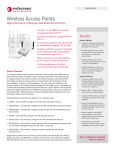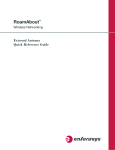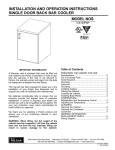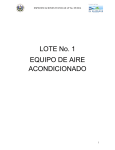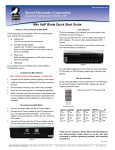Download Unify AP 2630
Transcript
DATASHEET Wireless Access Points High-performance, Enterprise-class WLAN Access Points Full 802.11n 3x3 MIMO functionality using standard 802.3af PoE Easy and cost-effective migration path to 802.11n Comprehensive wireless security services for authentication, encryption, IPS, and NAC Flexible architecture supports centralized and/or distributed traffic forwarding for voice/video/data applications Unified wired/wireless role-based access control with guest networking Product Overview The Enterasys Wireless solution optimizes distribution of the processing load between Access Points (APs) and wireless controllers to deliver exceptional performance while remaining easy to manage. Complex, time-sensitive functions such as QoS, encryption, policy enforcement and dynamic channel selection are handled by the AP, while global functions like configuration, roaming, security management, and policy control are centralized at the wireless controller. Furthermore, the innovative Enterasys Wireless VNS architecture is able to determine how to forward traffic for the highest performance and reliability for each application. The result is a WLAN infrastructure that can easily be leveraged to deploy VoWLAN and new high-performance solutions such as HD video applications. Enterasys Wireless Access Points are available in the following models: • AP3610/3620 – dual radio 802.11a/b/g/n thin APs with internal/external antennas • AP2605 – dual radio 802.11a/b/g thin AP with integrated antennas • AP2610/2620 – dual radio 802.11a/b/g thin APs with internal/external antennas • AP2630/2640 – dual radio 802.11a/b/g standalone APs with internal/external antennas that can be operated in thin mode • AP2650/2660 – dual radio 802.11a/b/g thin outdoor industrial APs with internal/ external antennas Purpose-built to enable voice and HD video communications across the WLAN, the Enterasys Wireless dual-radio 3x3 MIMO 802.11n wireless access point can be powered by a standard IEEE 802.3af PoE port found on most switches that form today’s wired networking infrastructure – making wireless mobility more practical, achievable, and cost-effective. This means that Enterasys 802.11n APs do not require a costly upgrade to higher-power 802.3at PoE switches. Similarly, enterprises are not required to pull extra Ethernet cables for additional power or limit the performance of APs by disabling a radio or falling back to 2x3 or 2x2 MIMO operation. Enterasys Wireless APs use the most sophisticated standards to ensure effective security and client compatibility. Using the 802.11i (WPA2) standard, wireless LAN deployments can utilize 802.1X or PSK authentication and AES, TKIP, or WEP encryption. These options ensure secure authentication and seamless integration of the APs with the wired network infrastructure. Benefits Business Alignment • Support for demanding voice/video/data applications to enhance mobile worker productivity and convenience • Role-based grouping of users, devices, and applications to deliver priority, QoS, and security in accordance with business needs • Seamless roaming across an entire multi-subnet campus without the need for cumbersome client software • Integrated management, security, and QoS features reduce operating cost and ensure a consistent user experience regardless of location Operational Efficiency • Centralized visibility and control from Enterasys Wireless Management Suite and Enterasys NMS accelerate problem resolution, optimize network utilization, and automate management • Migrate to 802.11n without requiring power, switching, or cabling upgrades • Adaptive architecture reduces complexity and optimizes information flow for each application • Dynamic Radio Management ensures optimal AP coverage and maximizes the availability and quality of wireless service across the enterprise • Wireless Distribution Service (WDS) enables Enterasys Access Points to wirelessly interconnect while extending WLAN service to distant areas There is nothing more important than our customers. Enterasys Wireless APs work together to prevent interference and optimize RF sharing. Each AP is able to intelligently and dynamically adjust its transmit power and channel based on information related to neighboring APs. This ensures optimal performance for all wireless clients. If an AP fails, neighboring APs will increase power to maintain coverage in the affected area. The APs also support RF channel plan selection with the option of supporting 3-channel, 4-channel, or a fully custom configuration. 802.11n Enterasys Wireless 802.11n APs are exceptionally power-efficient, ensuring that they can run on industry-standard 802.3af PoE infrastructure. Many 802.11n APs exceed the power consumption limits of the 802.3af standard specification for PoE when configured for 3x3 MIMO on both radios. These solutions demand the use of AC power adaptors or costly upgrades to pre-standard or proprietary PoE infrastructure to achieve optimal RF performance. Exceptional performance is delivered utilizing the 3x3 statistical diverse transmit function. 802.11n AP performance gains are best achieved in the 5 GHz band where more non-overlapping channels are available. To achieve the optimal 300 Mbps data rate, the Enterasys Wireless 802.11n AP can be configured to use channel bonding, combining two adjacent 20 MHz channels into a single 40 MHz channel. Additionally, the Enterasys Wireless 802.11n APs are DFS compliant and can offer up to 11 non-overlapping, bonded channels. This provides more flexibility when building high-throughput networks than with 802.11 APs which are not DFS compliant, as they are restricted to only 4 non-overlapping bonded channels. Plug and Play Enterasys Wireless Access Points will securely and automatically register with an available wireless controller and download their configurations, simplifying deployment and operational effort. APs can immediately provide service to users without having to be manually configured. Virtual Network Service (VNS) – An Adaptive WLAN Architecture Most WLAN solutions force network administrators to choose between a centralized or distributed architecture. A significant advantage of Enterasys Wireless is that it can support both deployment models simultaneously, offering significant flexibility benefits over other solutions. Network administrators can select the deployment model on a per-SSID basis, without any restrictions, so that the wireless LAN infrastructure can adapt to business requirements and applications. Benefits (cont.) Security • Authentication and authorization functions include role-based access control (using 802.1X, MAC, and captive portal) and authentication at the AP (802.1X supplicant) • Standards-based encryption (WEP, TKIP, WPA, WPA2, WPA-PSK,WPA-PSK2, and AES) at the AP • Wireless Intrusion Prevention (WIPS) functions provide continuous scanning, threat classification, rogue AP detection, and countermeasures against possible attacks • AP personality can change to full time and part time sensors to perform Wireless Intrusion Detection and Prevention (WIPS) for effective detection and prevention of rogue APs and other threats • Integration of security policies (NAC, IPS) across the wired/wireless networks enables quick diagnosing and resolution of security threats Support and Service • Industry-leading customer satisfaction and first call resolution rates • Personalized services, including site surveys, network design, installation, and training A centralized architecture requires all traffic to be backhauled to a centralized controller. With the higher data rates of 802.11n APs, traffic loads on the wired network can be much greater than those created by legacy 802.11a/b/g APs. Depending on the size of the WLAN deployment and how much data is forwarded to the centralized controller, significant congestion may result. A fully distributed deployment eliminates backhauling traffic to a controller but increases the processing complexity for real-time mobile applications that require seamless cross-subnet roaming (e.g. VoWLAN). This can force IT managers to either create a large broadcast domain or apply many VLANs. Enterasys Wireless Virtual Network Services control traffic flow by allowing traffic to be backhauled to a wireless controller or switched locally at the AP, on a per SSID basis. With local switching, the AP is still managed centrally by the wireless controller, but data is not backhauled to the wireless controller. This improves responsiveness and ensures that traffic does not unnecessarily traverse costly WANs or contribute to bottlenecks at aggregating switches. A VNS also provides role-based policies providing security, NAC, mobility, and QoS priority that can be implemented on a per user and per application basis. Page 2 Dynamic Radio Management (DRM) Quality of Service (QoS) Each Enterasys Wireless Access Point supports DRM. Although DRM is centrally managed and configured by the controller, DRM functions as a fully distributed system managing channels and transmit power allowing the WLAN infrastructure to adapt to RF interference (802.11 and others), heavy channel utilization, and AP failures. Enterasys Wireless APs support extensive functionality to ensure the best service for all multimedia applications. Enterasys Wireless APs use IP DiffServ/Precedence/TOS and 802.11e WMM to differentiate and prioritize wireless traffic. On the wired side, IP DiffServ/Precedence/TOS, and 802.1p are used to differentiate and prioritize traffic. Full RF Survivability For 802.11 traffic, Enterasys Wireless APs support additional QoS features including 802.11e TSPEC (Call Admission Control) and U-APSD (automatic power save) to ensure high quality and power efficient services for voice, video, and data applications. With the combination of the VNS architecture and DRM, Enterasys Wireless Access Points automatically adjust their settings to continue to optimally service clients when adjacent APs fail or when the link back to the controller fails. In addition, Enterasys Wireless APs can be configured to dynamically redirect traffic to a secondary wireless controller if the primary wireless controller fails. When the failover mode is enabled, APs automatically register to both a primary and secondary wireless controller, ensuring high availability of the WLAN service and robustness for real-time applications. Security Enterasys Wireless APs provide strong encryption and authentication with the use of 802.11i standards and captive portal. In addition, the original packet IP prioritization can be maintained on both the wireless and wired networks by enabling the Adaptive QoS mechanism. This feature allows tunneled and wireless packets to retain their IP prioritization value end-to-end. Furthermore, Enterasys Wireless APs allow IT managers to define custom mappings of different types of prioritization schemes to ensure that user traffic is properly differentiated when entering the wired network. Enterasys RoamAbout Access Point Investment Protection Previous investments in the Enterasys RoamAbout® 4102 Access Points can be leveraged through software upgrades that enable Enterasys Wireless operation. Enterasys Wireless APs can be configured as part time or full time sensors to detect rogue APs or to detect and contain security threats with the Wireless Management Suite (WMS) Wireless Intrusion Prevention System (WIPS). In addition, each AP can be configured with a certificate enabling the AP to authenticate to the wired network. The network is then fully protected against attempted re-use of the Ethernet port by unplugging the AP and connecting directly to the Ethernet cable, as a point of entry into the corporate network. Enterasys Wireless Access Points Supported Features AP2605 AP2610/2620 Management AP2630/2640/4102 Standalone Thin AP2650/2660 AP3610/3620 Plug’n Play Installation • Automatic Controller Discovery • Centrally deployed configurations and upgrades √ √ Needs to be converted to thin mode √ √ √ Web Management and Configuration √ √ √ √ √ √ Secure Remote Management √ √ √ √ √ √ Number of SSIDs Supported 16 16 16 16 Security 8 16 Standalone Thin Security via WEP, WPA (TKIP), WPA2 (AES), 802.11i, 802.1X √ √ √ (AP2630/40 do not support 802.1X) √ √ √ VPN Support: IPSec, PPTP, L2TP √ √ √ √ √ √ Rogue AP Detection mode √ √ √ √ √ √ √ (except AP4102) Rogue AP Sensor mode Page 3 Wireless Access Points Supported Features AP2605 AP2610/2620 Performance AP2630/2640/4102 Standalone Intelligent thin AP (Encryption, blacklisting, QoS and RF Management done by the AP) √ AP2650/2660 AP3610/3620 Thin √ √ √ √ Filtering at AP √ √ √ √ Wireless Distribution System (WDS) √ √ √ √ Fast failover and Session Availability √ √ √ √ √ Dynamic RF Management √ √ √ √ √ Dual concurrent, Dual band 802.11a (5GHz) and 802.11b/g (2.4GHz) connectivity √ √ √ √ √ √ Dual concurrent, Dual band 802.11a/n (5GHz) and 802.11b/g/n (2.4GHz) connectivity √ Voice Standalone Thin Quality of Service (WMM, 802.11e) √ √ √ √ √ √ Call Admission Control (TSPEC) √ √ √ √ √ √ Power Save (U-APSD) √ √ √ √ √ √ Fast secure roaming and handover between APs Pre-Authentication (Pre-Auth) Opportunistic Key Caching (OKC) √ √ √ √ √ √ √ √ √ √ √ √ √ √ √ √ Standalone Thin Simultaneous Voice calls (802.11b, G711, R>80) 12 12 6 12 12 12 Simultaneous users per radio 127 127 127 127 127 127 Capacity Technical Specifications AP2605 Data Rate • 802.11a: 6, 9, 12, 18, 24, 36, 48, 54 Mbps • 802.11b: 1, 2, 5.5, 11 Mbps • 802.11g: 1, 2, 5.5, 6, 9, 11, 12, 18, 24, 36, 48, 54 Mbps AP2610/2620/2630/2640/4102 Frequency Bands * 802.11a: • 5.15 to 5.25 GHz (FCC / IC / ETSI) 802.11b/g • 2.400 to 2.4835 GHz (FCC / IC / ETSI) Dynamic Channel Control DFS & TPC support (ETSI) Wireless Modulation • 802.11a: OFDM • 802.11b: DSSS • 802.11g: DSSS and OFDM Antennas Fixed External Antennas 2.4 / 5.0 GHz Interface and Indicators Auto-sensing 10/100bT Ethernet interface. LED indicating AP status and connectivity AP4102 has 1 x RS232 Console interface. Receive Sensitivity (typical) • 802.11a: 6 Mbps/-88 dBm, 36 Mbps/-77 dBm, 48 Mbps/-73 dBm, 54 Mbps/-69 dBm • 802.11b: 1 Mbps/-93 dBm, 2 Mbps/-90 dBm, 5.5 Mbps/-90 dBm, 11 Mbps/-87 dBm • 802.11g: 6 Mbps/-88 dBm, 36 Mbps/-77 dBm, 48 Mbps/-72 dBm, 54 Mbps/-70 dBm AP2650/2660 802.11a: • 5.15 to 5.25 GHz (FCC / IC / ETSI) • 5.25 to 5.35 GHz (FCC / IC / ETSI) • 5.47 to 5.725 GHz (ETSI) • 5.725 to 5.825 GHz (FCC / IC) 802.11b/g: • 2.400 to 2.4835 GHz (FCC / IC / ETSI) 802.11a: • 5.15 to 5.25 (FCC / IC / ETSI) • 5.25 to 5.35 GHz (ETSI) • 5.47 to 5.725 GHz (ETSI) • 5.725 to 5.825 GHz (FCC / IC) 802.11b/g • 2.400 to 2.4835 GHz (FCC / IC / ETSI) AP2610/30: Internal Antennas • 2.4 / 5.0 GHz - 4 dBi Gain AP2620/40: External Antennas • 2.4 GHz / 5.0 GHz - 4 / 5 dBi Gain • Various high-gain directional and omnidirectional antennas are approved. AP4102 Antennas: • Internal dual-band diversity antennas with connectors for optional external antennas. • External antenna connections: 1 reverse polarity SMA connector for 802.11a; 1 reverse polarity SMA connector for 802.11b/g Internal Antennas • [email protected] GHz, 4dBi@5 GHz External Antennas • Various high-gain directional and omni-directional antennas are approved. • 802.11a: 6 Mbps/-89 dBm, 36 Mbps/-78 dBm, 48 Mbps/-73 dBm, 54 Mbps/-70 dBm • 802.11b: 1 Mbps/-91 dBm, 2 Mbps/-90 dBm, 5.5 Mbps/-89 dBm, 11 Mbps/-87 dBm • 802.11g: 6 Mbps/-89 dBm, 36 Mbps/-79 dBm, 48 Mbps/-74 dBm, 54 Mbps/-72 dBm Page 4 Technical Specifications AP2605 AP2610/2620/2630/2640/4102 AP2650/2660 Power • 802.3af Power over Ethernet, Class 0 (12.95 Watts Max) • AC Power Adaptor - 5 VDC, 2 A • 802.3af Power over Ethernet, Class 0 (12.95 Watts Max) • AC Power Adaptor • AP2610/20/30/40: 6 VDC, 1700 mA max • AP4102: 48 VDC, 270 mA • 802.3af Power over Ethernet, Class O (12.95 Watts Max) • 48 VDC – 15 W • 110-230 VAC – 15 W Available Transmit Power * • 802.11a: – 5.15 to 5.25 GHz: 17 dBm (FCC/IC/ETSI) • 802.11b: 15 dBm (FCC/IC/ETSI) • 802.11g: 18 dBm (FCC/IC/ETSI); Transmit (selectable per radio): – 100%, 50%, 25% • 802.11a: – 5.15 to 5.25 GHz: 17 dBm (FCC/IC), 18 dBm (ETSI); 5.25 to 5.35 GHz: 18 dBm (FCC/IC/ETSI); – 5.470 to 5.725 GHz: 18 dBm (ETSI); – 5.725 to 5.850 GHz: 15 dBm (FCC/IC) Note 1: AP4102 does not operate on 5.25 GHz to 5.725 GHz (FCC/IC/ETSI) Note 2: AP2650/60 does not operate on 5.25 to 5.725 GHz (FCC) • 802.11b/g: 18 dBm (FCC/IC),15 dBm (ETSI); Transmit (selectable per radio): – 100%, 50%, 25%, 12.5%, 6.25% Compliance/Standards Ethernet IEEE 802.3 / 802.3u / 802.3af; Wireless IEEE 802.11a/b/g; WPA, WPAv2, WMM Safety UL / IEC / EN 60950-1; CAN/CSA 22.2 # 60950-1-03 UL / IEC / EN 60950-1; CAN/CSA 22.2 # 60950-1-03 UL 2043 Plenum Rating IEC / EN 60950 - 1; UL / CSA 60950-1 UL HAZLOC, FM, ATEX EMC & Radio FCC CFR 47 Part 15, Class B ICES-003 Class B EN 301 893 V1.2.3 EN 300 328 V1.6.1 EN 301 489 1 & 17 EN 55022:2006 EN 61000-3-2:2006 EN 60950-1:2006 EN 300 328 V1.7.1 EN 301 489-1 V1.6.1 EN 301 489-17 V1.3.2 EN 301 893 V1.4.1 EN 50385:2002 EN 50401:2006 FCC CFR 47 Part 15, Class B ICES-003 Class B FCC Subpart C 15.247 FCC Subpart E 15.407 RSS-210 EN 301 893 V1.2.3 EN 300 328 V1.6.1 EN 301 489 1 & 17 EN / UL 60601-1-2 EN 50385 EN 55011 (CISPR 11) Class B Group 1ISM EN 301 489-1 V1.6.1 EN 301 489-17 V1.2.1 EN 300 328 V1.6.1 EN 301 893 V1.3.1 EN 50385 1999/519/EC FCC CFR 47 Part 15, Class B Dimensions and Weight 20.9 cm (8.2”) x 12.5 cm (4.9”) x 2.6 cm (1.0”) 650 g (22.9 oz) AP2610/20/30/40: 40 mm x 115 mm x 175 mm (1.5” x 4.5” x 7”) AP4102: 21.83 cm (8.6”) x 13.73 cm (5.4”) x 3.27 cm (1.3”) AP2610/30 weight: 272 g (9.6 oz) AP2620/40 weight: 363 g (12.8 oz) AP4102 weight: 798 g (28.2 oz) (W x H x D) 251 mm x 251 mm x 72 mm (9.9” x 9.9” x 2.8”) Without optional PS adaptor: 2241 g (79.1 oz) With optional AC PS adaptor: 2433 g (85.8 oz) Environmental • Operating Temp: 0 to 50º C (32 to 122º F) • Storage Temp: 0 to 70º C (32 to 158º F) • Humidity: 15% to 95% (non-condensing) • Operating Temp: 5º C to 40º C (41 - 104º F) • Storage Temp: -40º C to 85º C (-40 - 185º F) • Humidity: 10% to 95% (non-condensing) • Operating Temp: -40 to 70º C (+60º C with optional Power Supply) • Storage Temp: -40 to 85º C • Protection – IP65, NEMA 4x • Humidity 95% Technical Specifications AP3610/AP3620 Data Rate • 802.11a: 6, 9, 12, 18, 24, 36, 48, 54 Mbps • 802.11b: 1, 2, 5.5, 11 Mbps • 802.11g: 1, 2, 5.5, 6, 9, 11, 12, 18, 24, 36, 48, 54 Mbps • MIMO Mode HT20 (1 data stream): 6.5, 13, 19.5, 26, 39, 52, 58.5, 65 Mbps • MIMO Mode HT20 (2 data streams): 13, 26, 39, 52, 78, 104, 117, 130 Mbps • MIMO Mode HT40 Normal GI (1 data stream): 13.5, 27, 40.5, 54, 81, 108, 121.5, 135 Mbps • MIMO Mode HT40 Normal GI (2 data streams): 27, 54, 81, 108, 162, 216, 243, 270 Mbps • MIMO Mode HT40 Short GI (1 data stream): 15, 30, 45, 60, 90, 120, 135, 150 Mbps • MIMO Mode HT40 Short GI (2 data streams): 30, 60, 90, 120, 150, 180, 240, 270, 300 Mbps Frequency Bands * 802.11a/n: • 5.15 to 5.25 GHz (FCC / IC / ETSI) • 5.25 to 5.35 GHz (FCC / IC / ETSI) • 5.47 to 5.725 GHz (FCC / IC / ETSI) • 5.725 to 5.825 GHz (FCC / IC) 802.11b/g/n: • 2.400 to 2.4835 GHz (FCC / IC / ETSI) Dynamic Channel Control DFS & TPC support (ETSI) Wireless Modulation • 802.11a: OFDM • 802.11n: 3x3 MIMO and 2 spatial streams • 802.11g: DSSS and OFDM • 802.11b: DSSS Antennas Internal Antennas (AP3610): 2.4 / 5.0 GHz , 3 / 6 dBi Gain, External Antennas (AP3620): 2.4 GHz / 5.0 GHz, 4 / 5 dBi Gain Interface and Indicators Auto-sensing 10/100/1000 Base-T interface. LED indicating AP status and connectivity Serial Console interface Page 5 Technical Specifications AP3610/AP3620 Receive Sensitivity (typical) • 802.11a: 6 Mbps/-93 dBm, 54 Mbps/-80 dBm • 802.11n 5 GHz HT20 Mode: 6.5 Mbps(MCS0)/-94 dBm, 130 Mbps(MCS15)/-72 dBm • 802.11n 5 GHz HT40 Mode: 15 Mbps(MCS0)/-89 dBm, 300 Mbps(MCS15)/-68 dBm • 802.11b: 1 Mbps/-93 dBm, 11 Mbps/-90 dBm • 802.11g: 6 Mbps/-92 dBm, 54 Mbps/-81 dBm • 802.11n 2.4 GHz HT20 Mode: 6.5 Mbps(MCS0)/-94 dBm, 130 Mbps(MCS15)/-74 dBm • 802.11n 2.4 GHz HT40 Mode: 15 Mbps(MCS0)/-88 dBm, 300 Mbps(MCS15)/-69 dBm Power 802.3af Power over Ethernet, Class 0 (12.95 Watts Max) • Typical Power: 11 Watts • Optional DC Power Supply: Input 100 - 240 VAC, Output: 48 VDC, .38 A maximum, 0 to +40º C Available Transmit Power * 802.11a (FCC / IC) ( OFDM \ HT20 \ HT40): • 5.15 to 5.25 GHz: 15 dBm \ 15 dBm \ 15 dBm • 5.25 to 5.35 GHz: 18 dBm \ 18 dBm \ 15 dBm • 5.47 to 5.725 GHz: 18 dBm \ 18 dBm \ 16 dBm • 5.725 to 5.825 GHz: 22 dBm \ 22 dBm \ 22 dBm 802.11a (ETSI) (OFDM \ HT20 \ HT40): • 5.15 to 5.35 GHz: 17 dBm \ 17 dBm \ 17 dBm • 5.500 to 5.700 GHz: 22 dBm \ 22 dBm \ 20 dBm 802.11b: (FCC / IC) (CCK \ OFDM \ HT20 \ HT40): • 2.400 to 2.4835 GHz: 23 dBm \ 19 dBm \ 21 dBm \ 18 dBm 802.11b: (ETSI) (CCK \ OFDM \ HT20 \ HT40): • 2.400 to 2.4835 GHz: 15 dBm \ 15 dBm \ 15 dBm \ 15 dBm Compliance/Standards Ethernet IEEE 802.3 / 802.3u / 802.3af; Wireless IEEE 802.11a/b/g/n; WPA, WPAv2, WMM Safety UL / IEC / EN 60950-1 ; CAN/CSA 22.2 # 60950-1-03 UL 2043 Plenum Rating European 2006/95/EC Low Voltage Directive EMC & Radio • FCC CFR 47 Part 15.107 and 15.109 Class B (FCC 47 CFR, Part 15.205, 15.207, 15.209, FCC 47 CFR, Part 2.109, 2.1093, FCC OET No. 65) • FCC 47 CFR, Part 15.247, Part 15.407 • ICES-003 Class B • RSS-210, RSS-102 (RF Exposure) • R&TTE Directive 1999/5/EC • EN 301 893 • EN 300 328 • 89/336/EEC EMC Directive • EN 301 489 -1 & 17 • EN55011/CISPR 11 Class B, Group 1 ISM • EN55022/CISPR 22 Class B • EN55024/CISPR 24 • EN 300 386 • EN / UL 60601-1-2 • EN 50385 Dimensions and Weight 214.6 mm x 180.8 mm x 55 mm (8.4” x 7.1” x 2.2”) • AP3610 weight: 628.4 g (22.2 oz) • AP3620 weight: 649 g (22.9 oz) Environmental Operating: Temperature 0º C to 50º C (32º F -122º F), Humidity 0%-95%, (non-condensing) Storage: Temperature -5º C to 50º C (23º F -122º F) Transportation: Temperature -40º C to 70º C (-40º F - 158º F) * Bands, frequency and maximum power settings will vary according to channel and individual country settings. Page 6 Ordering Information Part Number Description Thin Access Points WS-AP2605 Dual Radio 802.11a/b/g indoor access point with integrated dual-band diversity antenna WS-AP2610 Dual Radio 802.11a/b/g indoor access point with internal dual-band diversity antenna WS-AP2620 Dual Radio 802.11a/b/g indoor access point with external dual-band diversity antenna WS-AP2650 Dual Radio 802.11a/b/g outdoor access point with internal dual-band diversity antenna WS-AP2660 Dual Radio 802.11a/b/g outdoor access point with RP SMA connectors WS-AP3610 Dual Radio 802.11a/b/g/n indoor access point with internal dual-band antenna WS-AP3620 Dual Radio 802.11a/b/g/n indoor access point with external dual-band antenna Standalone Access Points WS-AP2630-EU Dual Radio 802.11a/b/g standalone indoor access point with internal dual-band diversity antenna (Can be operated as a thin AP). Note: External power supply may be ordered separately (WS-PS261020-xx) WS-AP2640-EU Dual Radio 802.11a/b/g standalone indoor access point with external dual-band diversity antenna (Can be operated as a thin AP). Note: External power supply may be ordered separately (WS-PS261020-xx) Mounting Kits WS-MB2605-01 Mounting bracket for AP2605 WS-MB261020-01 Mounting Kit for electrical box mounting for AP2610/AP2620/AP2630/AP2640 WS-MB261020-02 Adaptor plate for electrical box mounting for AP2610/AP2620/AP2630/AP2640 WS-MK265060-01 Mounting Kit for rail or pole mounting for AP2650/AP2660 WS-MB361020-01 Secure mounting Kit with Kensington lock slot and integrated cable routing for AP3610/AP3620 Warranty As a customer-centric company, Enterasys is committed to providing quality products and solutions. In the event that one of our products fails due to a defect, we have developed a comprehensive warranty that protects you and provides a simple way to get your products repaired or media replaced as soon as possible. Enterasys Wireless Access Points come with a one year warranty against manufacturing defects. For full warranty terms and conditions please go to: www.enterasys.com/support/ warranty.aspx. Service & Support Enterasys Networks provides comprehensive service offerings that range from Professional Services to design, deploy and optimize customer networks, customized technical training, to service and support tailored to individual customer needs. Please contact your Enterasys account executive for more information about Enterasys Service and Support. Power Supply (non-PoE) WS-PS2605-MR AP2605 AC Power Supply - Multi-Region WS-PS261020-NAM AP2610/AP2620 AC Power Supply for North America WS-PS261020-EU AP2610/AP2620/AP2630/AP2640 AC Power Supply for Europe (Except UK) WS-PS261020-UK AP2610/AP2620/AP2630/AP2640 AC Power Supply for UK WS-PS261020-CN AP2610/AP2620/AP2630/AP2640 AC Power Supply for China WS-PS261020-AU AP2610/AP2620/AP2630/AP2640 AC Power Supply for Australia WS-PS265060-MR AP2650/AP2660 AC Power Supply - Multi-Region WS-PS361020-MR AP3610/AP3620 AC Power Supply - Multi-Region Contact Us For more information, call Enterasys Networks toll free at 1-877-801-7082, or +1-978-684-1000 and visit us on the Web at enterasys.com Patented Innovation © 2009 Enterasys Networks, Inc. All rights reserved. Enterasys Networks reserves the right to change specifications without notice. Please contact your representative to confirm current specifications. Please visit http://www.enterasys.com/company/trademarks.aspx for trademark information. 07/09 Delivering on our promises. On-time. On-budget.







